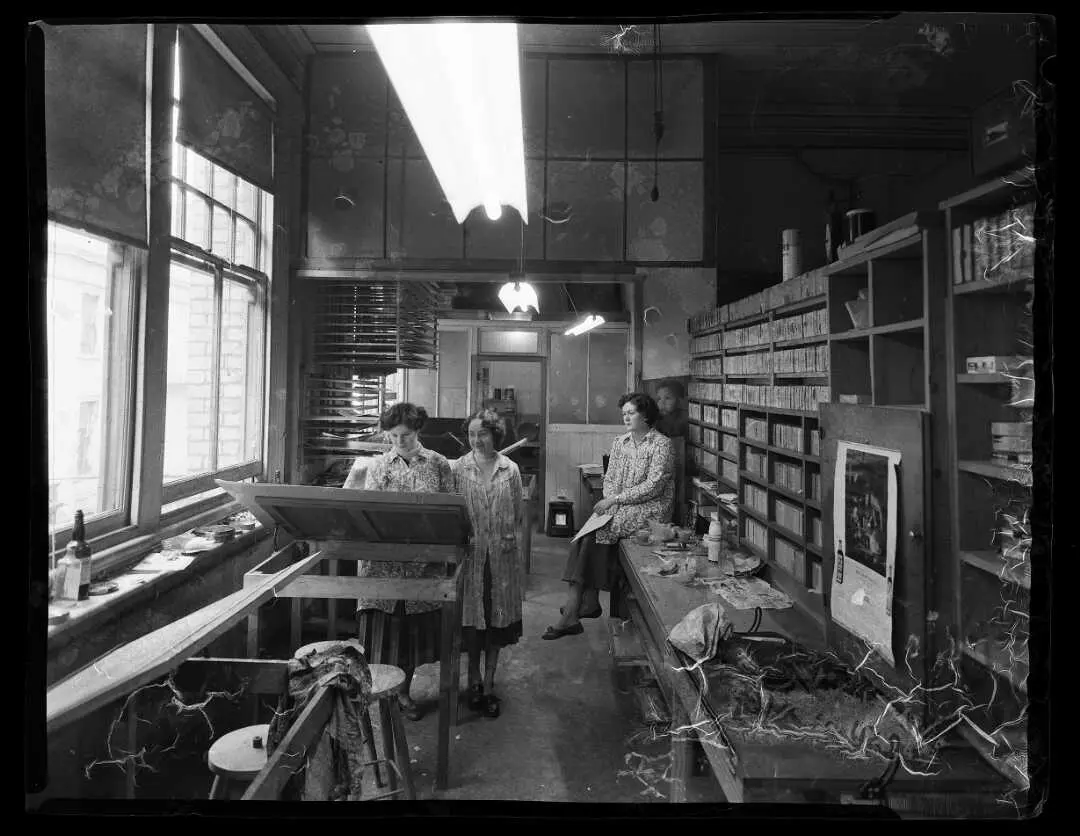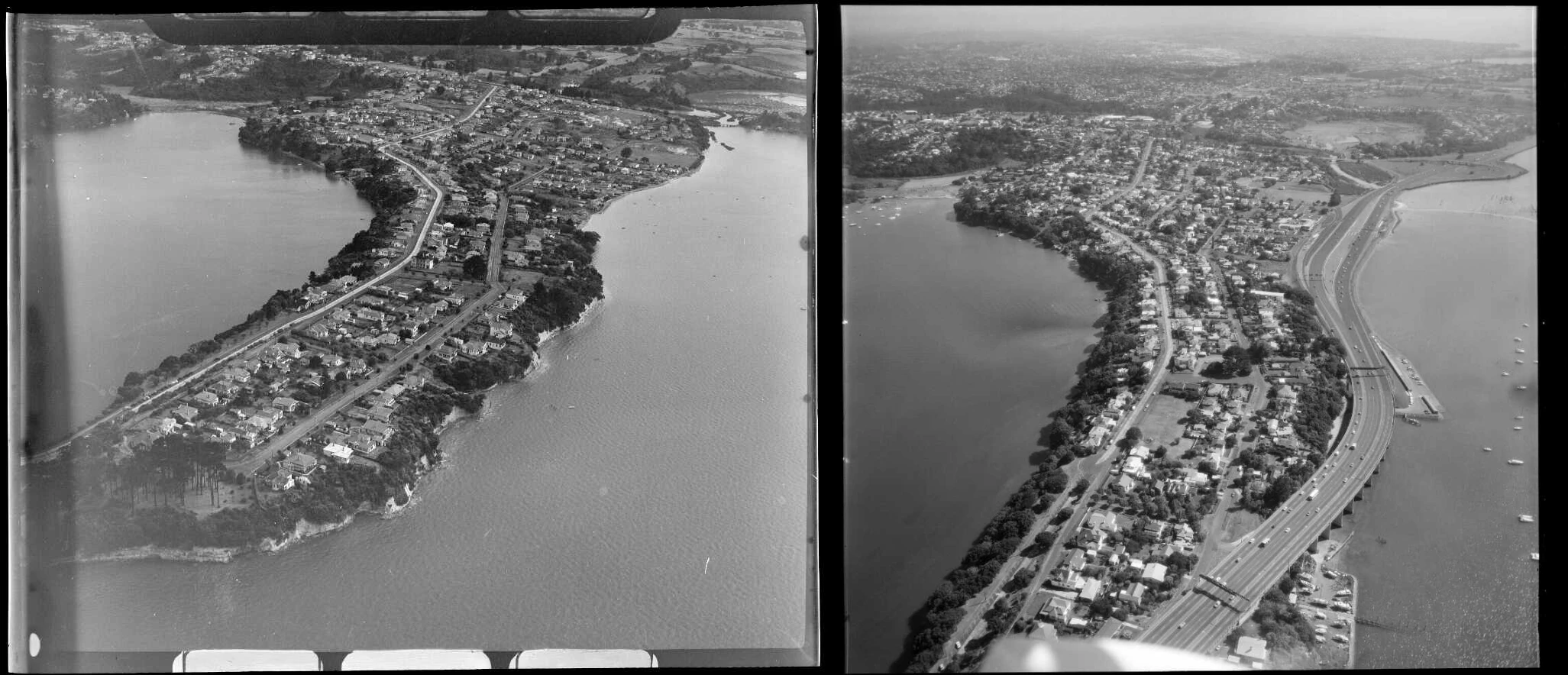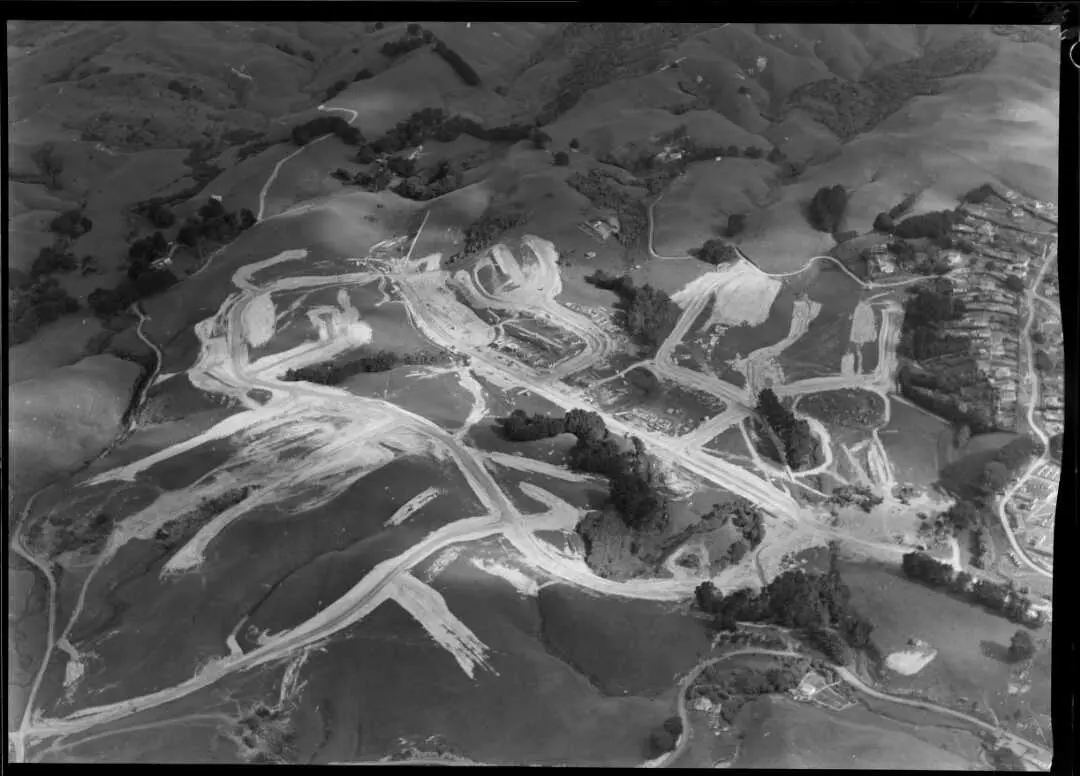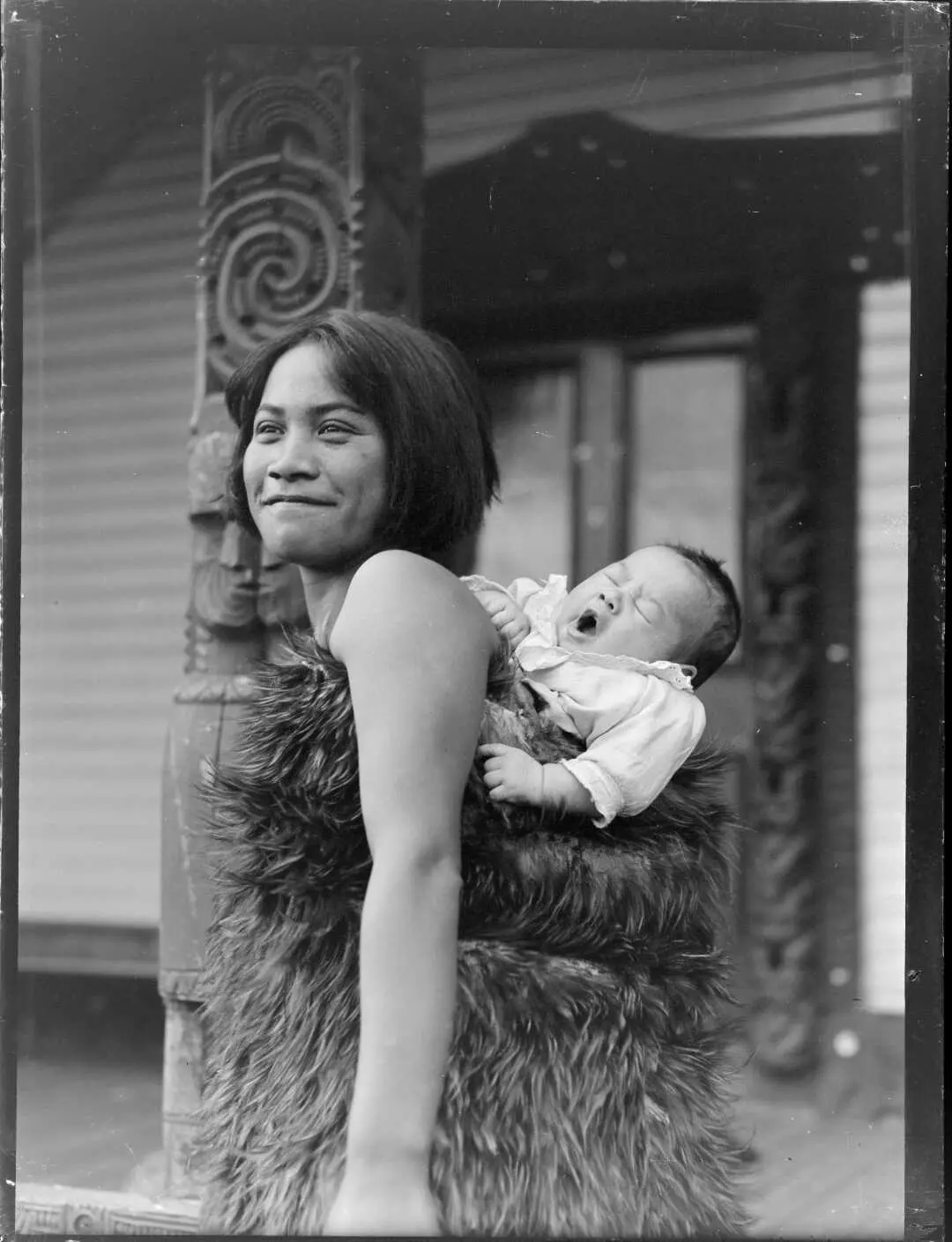The view from above
The National Library and Alexander Turnbull Library are currently in the middle of a large project to apply clear and consistent rights statements to all our collections, digital and analogue, new and old. Our commitment to follow the government’s NZGOAL policy and our own Use and Reuse Policy means that we must improve the copyright information about our collection items and make collections more openly usable where we can.
During this complex piece of work, the leader of Arrangement and Description at the Turnbull Library, Nicola Frean, noticed that the Library had bought the copyright to a large, popular collection of aerial photographs, Whites Aviation. It’s unusual for the Library to own the rights associated with our collections. Until that point, we used our ownership of the rights to Whites Aviation to approve each request to use the images individually. Nicola immediately realised that we could be doing much more to open up this collection.
Therefore, we decided to release a set of post-1945 aerial photographs from the Whites Aviation collection under the Creative Commons Attribution 4.0 (International) licence. This will enable commercial reuse of these images, without the researcher having to contact the Library for permission. We are also releasing them as part of our free download pool so that commercial reuse is enabled by high-resolution versions of the images.
In this blog, we want to tell you a little about the Whites Aviation collection and the changes that the Library is making to the management of its rights. We hope you’ll learn a bit about this important area of our work and a newly-open source of information about New Zealand history.
Who were Whites Aviation?
Already well-known as an aerial photographer and aviation enthusiast, Leo White (1906-1967) formed the company Whites Aviation in 1945.

Whites Aviation Staff, 1956. Ref: WA-44609. Alexander Turnbull Library, Wellington, New Zealand.
The above image shows the Whites Aviation office with one of the ‘girls’ hand-colouring a print while others watch. Other prints are lying in racks behind. The shelves to the right contain negatives of the Whites Aviation collection. The negative this image was taken from shows early signs of ‘vinegar syndrome’ where the acetate backing has begun to shrink causing the negative to wrinkle, often to the point where the image can no longer be seen. These images can be made viewable by our conservation team by removing the backing, but this is a slow and painstaking process and only done as required. Environmental conditions in the Library ensure the negatives will not deteriorate any further. You can find further information about our conservation of images in this blog: The vice inherent in photographic film.
The company published the monthly magazine called ‘White’s Aviation’ and several editions of ‘White’s pictorial reference of New Zealand’ many smaller one-off publications covering the towns and provinces. [All of these publications](https://natlib-primo.hosted.exlibrisgroup.com/primo-explore/search?query=creator,exact,whites%20aviation&tab=catalogue&search_scope=NLNZ&vid=NLNZ&offset=0” class=) and many others over the years have featured the photographs taken by Whites Aviation.
The photographs mainly cover towns throughout New Zealand, with some rural photographs and scenic hotspots. Some smaller towns may have been covered only once or twice, while larger towns and cities, particularly Auckland and surrounds, were covered multiple times from the 1940s (and earlier) to the 1980s. The 1950s and 1960s were particularly productive with extensive photography all around New Zealand, but the last time Whites photographed any part of the South Island appears to have been in 1974. Unlike the other well-known company, New Zealand Aerial Mapping, Whites Aviation had no mandate to cover the entire landmass of New Zealand so presumably they focused on what would be of greatest interest and commercial value to their company.

L: View of Northcote Peninsula before construction of the Auckland Harbour Bridge, 1946. Ref: WA-02314-F R: View of Northcote Peninsula after construction of the bridge, Auckland, 3 March 1988. Ref: WA-80187-F

Porirua housing site, Wellington, 27 November 1949. Ref: WA-23366-F
The company was also employed to take photographs by various authorities and companies and so the collection has an extensive range of images such as motorways under construction, forestry plantations and new subdivisions, as can be seen in the image above.
After the death of Leo White, the company was sold to Shane Niblock from Modern Productions Ltd and continued under his ownership until 1988 when it was bought by Air Logistics, which later became GeoSmart, (now known as Aerial Surveys Ltd).
In 2007 Geosmart made the decision to move away from aerial photography and offered the collection to the Alexander Turnbull Library. The Library bought not only the collection of about 80,000 negatives and 55,000 prints, along with the negative registers, but also the copyright to these images. The images included a large collection of photos taken by Leo White from 1921 onwards as well as the post-1945 photographs from the Whites Aviation company.
When the Library had the opportunity for a mass-digitisation programme (known as Pictures Online) in 2010 - 2012 the Whites Aviation collection was an obvious choice. The collection was extremely popular with researchers, was well-organised, and, because the Library held copyright for the collection, it was felt at the time that there would be no issues regarding use of images. To speed up the process, scant records (title and date only) were created from the place name and date information provided in the negative registers. Some of the listers provided more information in the title depending on how well they knew the area. Place name authority terms have since been provided as part of a later project.
One of the issues we have since found is that many of the negatives were scanned in reverse, so the image is showing as a mirror image of itself. If you do find any like that, please let the Library know!

Southern motorway, Manurewa, Auckland. Ref: WA-56035-G
What’s so important about copyright?
The National Library of New Zealand and the Alexander Turnbull Library hold millions of items in our collections. These collections are the result of 100 years of our collecting, protecting, preserving, and making accessible information about New Zealand, the Pacific, and Antarctica.
Each item in the collections has a different legal copyright situation and other legal or cultural rights that may affect how they are able to be reused.
We want the people of New Zealand to not only find and read (or view, or listen) to our collections, but to use them to create new knowledge, and new ways of understanding our country and its place in the world. That said, we also want to protect the rights of the people who created the content in our collections and are represented within them.
The Whites Aviation collection is a great example of why copyright is sometimes difficult to work with for an institution like ours. While the Library could buy the rights for the collection, that doesn’t mean that the rights to each image in this collection are all the same. Some images are still in copyright, some are out of copyright, some are out of copyright but have cultural or ethical considerations, some we don’t have the information to understand what status they should be. Other images from White’s Aviation that we did not purchase under contract might have rights that belong to other people or organisations.
What is the Library changing about Whites Aviation?
When the Library realised the opportunity was there to release Whites Aviation’s images under an open licence, allowing for very broad, open reuse of an image, we were faced with several questions.
What portion of the collection is in copyright, as we can only apply Creative Commons licences to in-copyright material?
The copyright term is based on the death date of the creator of the material. We know that Leo White (who died in 1967) was the principal photographer, and his identified work is out-of-copyright. However, we also know that he hired other photographers who would have created a significant number of images in the collection. Most of the later material in the collection is not identified as being created by Leo White, but we do not have precise information about who the creators were. Based on the age of the material, we have determined that the post-1945 images are, on balance of the evidence we have, likely to still be in copyright.
Is privacy law a barrier to releasing this collection openly?
Broadly speaking, privacy law affects images in our collection where the person depicted in the image had an expectation that the image was only for them and people they choose to share it with, e.g. taken in the home, a candid shot, or clearly not intended for display outside a private collection. It can also only apply to living people. We determined that any images of people that might meet these criteria would not be openly licensed and decided to focus on aerial photographs to reduce the risk of breaching people’s privacy. Again, if you see any images with a CC-BY Creative Commons licence that show identifiable people, please let us know.
Can the Library release the out-of-copyright material openly as well?
Many items in this collection, like the wonderful image of a woman carrying her baby, below, are out of copyright because they either were created before 1944 or are identified as being taken by Leo White, or both. Therefore, they are legally available for reuse by anyone, for any reason. However, as part of our wider rights statement project the Library has committed to considering several important influences on use and reuse in New Zealand before we endorse a completely open commercial approach with our out-of-copyright material.
First is our role as part of the government’s response to the WAI262 Waitangi claim ‘Ko Aotearoa tenei’. This claim raises questions about the fitness of current New Zealand copyright law to address the “concern about photographs of Māori being used in a commercial context without permission” (p.38 of v.1). The report encourages institutions like us to “find new ways of resolving these tensions (between access to and protection of mātauranga Māori) so that rules developed in the name of rangatiratanga do not have the unintended effect of distancing Māori from their mātauranga”(p.189 v.1)
The second is the in-flight consultation over a new, refreshed copyright law, which may take such considerations into account or recommend other legal remedies for them. What is written into this law may change how we assess items for open reuse.
Thirdly, our own use and reuse policy requires us to give “careful consideration of cultural and ethical issues relating to the items” before we release them for completely open reuse. This is a very broad assertion and raises a variety of associated questions such as ‘whose culture?’ ‘whose ethics’ and most importantly ‘how?’

Maori woman carrying a young child on her back wrapped in a feather cloak. Ref: WA-12537-G
What’s next for Whites Aviation?
The Library is committed to finding a workable solution that allows us to release out-of-copyright collections for appropriate reuse. While we work on this and talk to as many people as we can about the best way to do it, collections like Whites Aviation give us a good training ground for considering these issues. We have a goal of applying correct rights statements to all the images in this collection by the end of 2019.
We hope that you’ll find the newly open Whites Aviation images useful for school projects, art works, studies of land use, urban planning, and agricultural history. We hope you’ll find them useful for things we haven’t even thought of.
Co-authored by Jenni Chrisstoffels, Research Librarian, Pictorial; and Amy Watling, Online Research Services Leader at the Alexander Turnbull Library.
Teaser image: Percival Proctor monoplane ZK-APH, in flight, Waikato Aero Club. Ref: WA-12888-G
If you wish I can help the National Library in identifying the majority of the Whites Aviation photographs taken of the East Tamaki / Papatoetoe Rural District in 1949. I am in my 80's but I have an extremely vivid memory of my childhood and the community I lived in that included our farming days on what is today known as Ormiston Road. I can in fact remember the aeroplane and the excitement it caused in 1949, and in my teenage years I worked the hay harvesting season on many of the districts farms and in school holidays milked a number of the districts small herds of cows. I have already written twenty thousand words on the history of our farm as the family's ownership started in 1864. East Tamaki's European farming history means a lot to me as four of my great, great grandparents are buried in a district they greatly loved. The Whites Aviation photographs are being used by me in addresses to our Ormiston Probus and U3A groups and also the Otahuhu and Papatoetoe Historical Societies.
Everett Thorburn
Thank you Everett, your offer of assistance is very much appreicated. We will be in touch via email to discuss further. Ngā mihi